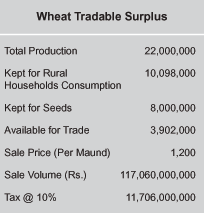In 1997, Vietnam, a predominantly agricultural country where 80 percent of the population is rural, lifted the internal and external trade restrictions on rice: its main staple. 95 percent of urban households are net buyers of rice and a North-South divide exists in terms of rice production. The incidence of poverty in the rural areas,
45 percent, is much higher than that in the urban areas: 10-15 percent. The proportion of income spent on food items for poor households is 63 percent. Real prices rose after the removal of trade restrictions for all the households.
However, a recent study linking household welfare and trade reforms by the World Bank shows that the trade reforms were “broad-based and pro-poor” (Aylin Isik-Dikmelik 2006). The study concluded that the trade reforms benefited all households whether they were net buyers or sellers. Vietnam recorded drastic reduction in poverty incidence following these trade reforms.
What path does Pakistan, sharing many characteristics with Vietnam, need to follow, while struggling to confront the wheat crisis? This forms the sole objective of this article.
In Pakistan, again, primarily an agricultural economy, economic liberalism has been accepted as the ‘bible’ of all economic decisions. Except in the case of agriculture itself. In manufacturing, we embraced the post-quota world many years ago. In services such as banking, telecom, insurance or wholesale trade the free market rides. In recent years, economic growth has been mostly propelled by the services industry, where the free market forces have been allowed to work relatively independently.
Why we continue to religiously control the agriculture sector is both a political and economic question.
Market-based Equation Dynamics
The economic equation is fairly simple, at least in its classical tone. When the price of any commodity rises, the profit margins of producers rise and in an open economy, it attracts new producers. In our case – that would mean more farmers planting wheat.
The entry of new producers increases the supply. Which in turn ultimately brings down the prices as well as the profit margins. Thus, the market reaches a classical equilibrium point.
Obviously, this does not work as neatly in the real world. Claiming ‘market failure’ as their excuse, the government intervenes.
Apparently, this state intervention leads to a worse failure, due to ‘rent seekers’. The bureaucrats are not simply trained or well-informed for making business decisions and they tend to give leeway to cronies. Therefore, mafias and cartels emerge, which monopolize sources of production and this leads to a concentration of wealth.
Equation Policy Lag Shrunken
Economic liberalism, argued for in this article, demands for the removal of entry and exit barriers from trade and argues that given a fair chance, the market is a far more efficient and just mechanism for resource allocation.
Economic Liberalists argue that the removal of trade restrictions in the wheat market -both internal and external- is more beneficial for all the sections of the economy in the long run. Particularly because, in the case of the wheat market -unlike capital intensive development- the policy lag would be fairly short.
The reason is simple: the farmers, once they get the right price signal, would cultivate more wheat – and a decision by the farmers to switch their cultivation – would normally take six months to a year. Thus, potentially within a year even, we will be able to produce more wheat, which will offset the demand. Consequently prices will come down.
Land Prices Shoot Higher Still
The United Nations International Fund for Agriculture and Development (IFAD) has reported that rising food prices are already stimulating a supply response. In Ghana for example, the corporate sector is reacting quickly, especially in the maize sector. In many parts of the developing world this is reflected as an increasing demand for land, particularly from large scale investors. In Senegal, the demand is particularly high for irrigated land. In Egypt, both the purchase and rental prices for land are soaring.
We should expect to have a similar response in Pakistan to an increase in the prices, provided we allow the market to work.
If the price of the land increases, the owner of the land is likely to become wealthier. If the price of a product increases, the producer is likely to benefit. Theoretically, of course.
The Real Cause: Inflation or Production
Consider inflation and its effect on the low-income household budget, a large chunk of which comprises food.
In 2006, the Pakistan Institute of Development Economics (PIDE), run by the government, published a joint study on Wheat Pricing policy, which was conducted by a team drawn from the World Bank and Pakistan Agriculture Price Commission. This study concluded that: “analysis of price multipliers indicates that increases in wheat procurement prices (one means of promoting domestic procurement) have relatively small effects on overall price levelsâ€. It also concluded that “market forces play a dominant role in price determination in Pakistan, and that policies that promote the private sector wheat trade can both increase price stability and reduce fiscal costs”.
Conclusively the study held that “fluctuations in production, rather than market manipulation, are plausible explanations for price increases in recent years”.
The current wheat crisis is driven by a production shortfall, as concluded in the PIDE study. When wheat is imported to offset the production shortfall, we end up supporting a wheat grower somewhere in Australia or the United States. Would it not be better to pay our own grower an international price? Given that the price signal is the only effective way (in my humble, liberal opinion) to enhance the production and hence stabilize the price.
The acuteness of our production shortfall in the coming crop can be gauged from the simple fact that the usage of the main input, phosphate, was 50 percent less than in the previous year. If the growers of wheat are given appropriate price signals, who would knowingly reduce the cultivation of wheat?
Facades of State Intervention
The government intervention in purchasing and storage through PASCO (Pakistan Agricultural Storage and Services Corporation) has also taken an nasty turn. A recent article in Dawn revealed that a staggering 2 million to 4 million tons are ‘missing’ from the market. The farmers would not like to be coerced by government functionaries and they instead tie knots with private investors – the infamous middleman – who promises to pay them more than the market. In practice, that is exactly what is happening. If you visit an average village in Punjab and talk to a wheat grower, he will readily tell you how he does not care about the support price of the government. The market effectively controls the price movements but the state continues to masquerade its delusion of control.
As a matter of fact, when the government takes matters, like fixing a quota for flour mills, in its own hands, the issue of nepotism and rent seeking surfaces rapidly. How can we trust our government officials to be well-informed, transparent and fair while determining the quota for thousands of flour mills? Instead we should admit that the flour processing market is a near perfect market in the sense that no single player -or a cartel- is in a position to influence the market. If we can trust the ‘invisible hand’ for a moment, it is highly likely to create a win-win scenario.
Opponents of the free market in the wheat market erroneously argue that the benefit of a higher price would be largely taken by land lords and small to medium wheat growers would not benefit much. To determine the credibility of such a statement, we must know the composition of ownership of agriculture farms.
The Pakistan Agriculture Census 2000 reports that wheat is grown on 75 percent of privately owned farms. 94 percent of Pakistan’s wheat cultivated area is owned by farms of less than 25 acres in size, which suggests that wheat production, just like the SME phenomenon in manufacturing, is largely characterized by small to medium farm owners. In fact only 10 percent of farms are equal to or less than 1 acre, and their produce is only for self-sufficiency and does not reach the market.
We argue that the great majority of this price hike -to be fair, we mean trade freedom- would belong to the rural poor and lower middle class. We now show an estimate of the wheat tradable surplus and its implications for our fiscal policy, provided market prices prevail.
The free market principle should, theoretically, come full circle. Once the agricultural market is free of state intervention, either via state subsidized inputs or by support price, then,, agricultural income should be taxed. If a tax rate of 10 percent – like Ushr – is levied, then it is likely to generate tax revenues close to Rs. 11.70 billion. If need be, it is this wheat generated income, which should be utilized to provide the wheat-flour to the poor, whether urban or rural, in a market friendly fashion. Even for this, we argue that privately managed utility stores are a much better option than food coupons or cash grants, which are more likely to be mismanaged or misused. Studies have shown time and again how cash grants are always misused and the food coupons issued in the late nineties proved ineffective.
Advocating the free market principle in the agricultural market with the backdrop of raging poverty and endless queues for Atta (wheat flour) indeed sounds dismal and against egalitarian principles. However, who likes getting an injection or undergoing surgery?I It is always painful. But, who amongst us would not consider bearing that temporary pain, which is critical for our own well-being in the long-term?
Economic liberalism proposes a bitter pill, but believes in it as a panacea for the illnesses of our economy. And so it must be swallowed – and the sooner, the better.








